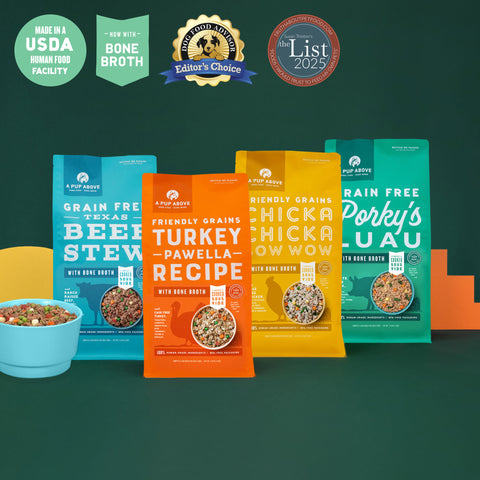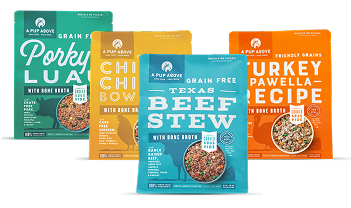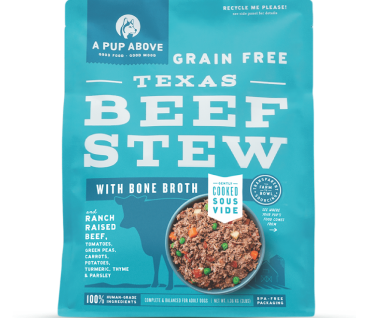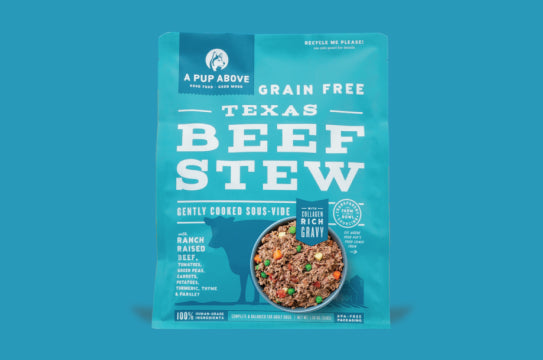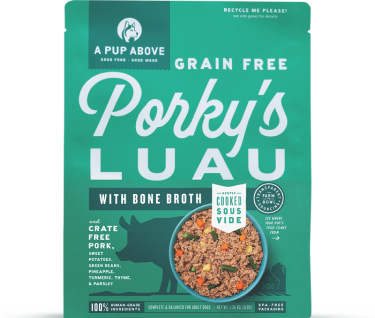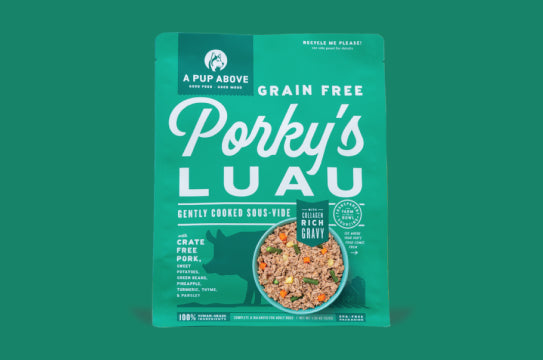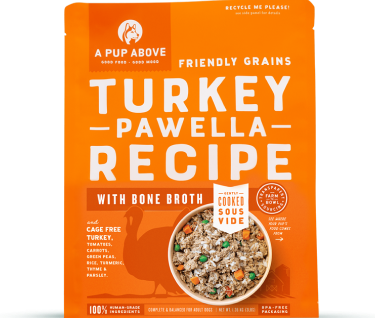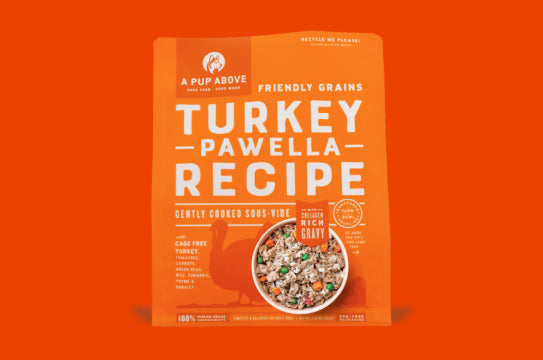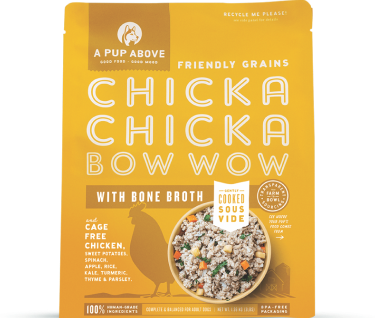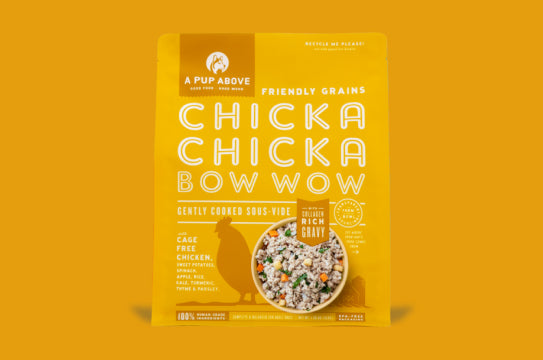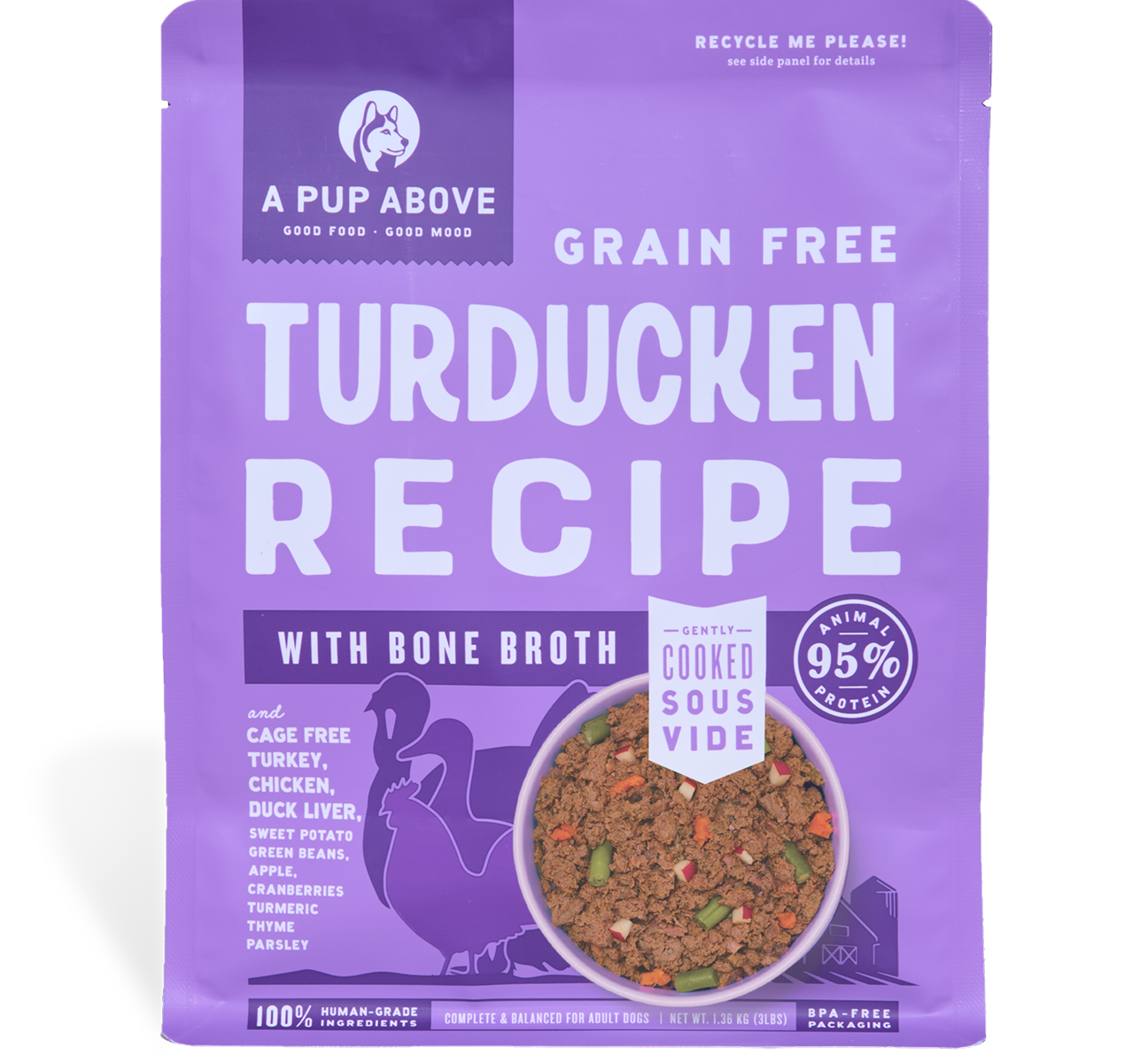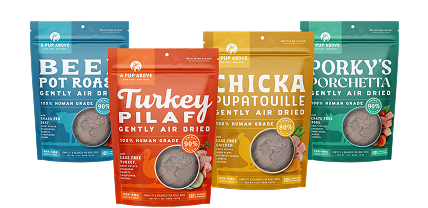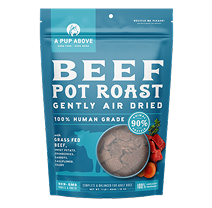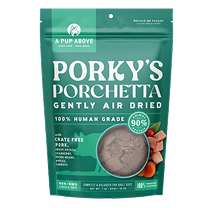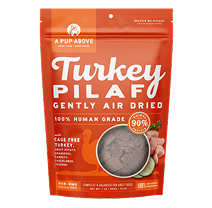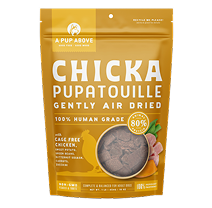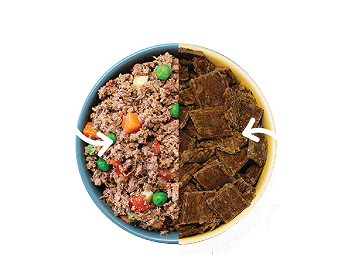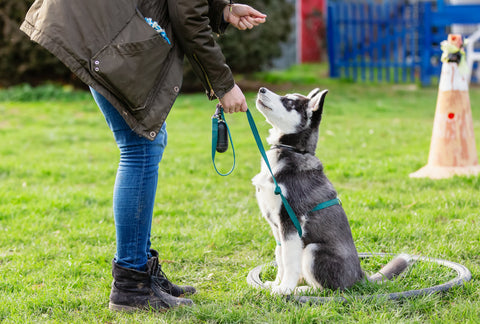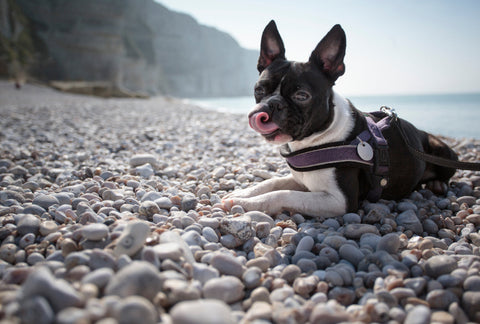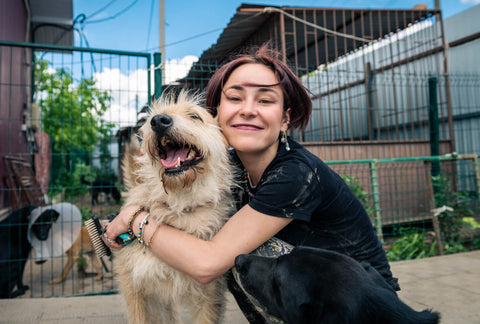
Switching dog food? Why and how to change to fresh
When you think of dog food, you might automatically picture kibble. But did you ever stop and ask yourself why? Dog food is not kibble — and you don’t have to think of it that way any more.
If you’re one of the many dog owners who’ve re-imagined what dog food can be for your precious pet, you might be wondering - what’s the best way to switch a dog’s food?
Glad you asked! Whether you’re switching a dog to homemade food or a fresh, meat-forward brand like A Pup Above, here’s how to change your dog’s foods without upsetting your sweet pup’s insides.
How to change dog foods: the process
Kibble is heavily processed and not as rich in meat as you might think. Moving towards a more meat rich diet requires a gradual transition that allows the digestive system time to adjust.
If you’re switching dog food from dry kibble to something fresher, healthier, and altogether yummier, you need to take it slow. Think of it as if you had been a vegetarian for years, then decided to eat meat. It’s a process you wouldn’t want to rush.
Yes, your dog will likely love the new food. But watch closely to see how your dog is doing. Some pets adjust to changing dog food in just a few days. Others may need as long as a week to ten days. More sensitive pets with delicate stomachs can take even longer. Try these steps:
- Add New Food Gradually
Plan a gradual break-in period for the new food. Slowly wean your dog off the old food while gradually introducing the new.
Days 1-3:
- Start by putting 3/4 of a typical serving of your dog’s current food in the bowl.
- Then, fill out the final 1/4 of the meal with the new food.
- Watch your dog get excited — but more importantly, notice how your dog seems to feel after meals over these first few days.
Days 4-7:
- Ask yourself: Did my dog handle the switch to new dog food well during days 1-3?
- If no, or your pet’s stool seems soft or loose, take a step back and introduce the new food more slowly.
- If yes, offer the new food for the whole morning meal, then the old food for their evening meal.
- Or, if you prefer, do a 50/50 mix in their bowl for every meal.
Days 8+:
- Ask yourself: Did my dog handle the new food well during days 4-7?
- If no, give transition more time by staying in the day 4-7 pattern, or even dropping back to the day 1-3 pattern for a day or two.
- If yes, you’ve successfully switched dog foods! You can now feed fresh foods for both meals.
In general, the best way to switch a dog’s food is gradually, but there’s no need to fear if things move fast. Many pets transition quickly and gobble fresh food with excitement right away — or as one owner put it, “like a total maniac!”
By the way, eating too quickly can be rough on your ruff-ruff’s system. If you think your dog eats too fast, look into slow-feeder bowls to slow them down.
- Check Your Dog’s Poop
Wondering how to tell whether your dog is handling a new diet well? Check the poop. You want to see firm, healthy looking stools.
During the process of switching dog foods, you may see your dog’s poops lose shape. If this happens, simply slow down the transition to give your dog’s digestive system more time to adjust.
That said, you will see some pretty cool changes when you successfully transition to fresh food. You’re going to like them, trust us.
After switching your dog’s food to homemade or fresh, your dog’s poops will be greatly reduced in size. They will be small, firm, and void of any offensive order. That’s because your dog’s body can absorb fresh food nutrition without having to cope with highly processed, dried ingredients.
It’s healthier for your dog, and all around nicer for you. What a bonus!
- Include a Probiotic
For pets with severe digestive and/or gastrointestinal upset, we recommend adding a digestive enzyme to aid with the switching process from kibble to fresh dog food.
Giving your dog a probiotic supplement, or probiotic-containing food like goat’s milk yogurt will help with this. Yogurt made from goat’s milk is easier on dogs’ stomachs than that made with cow’s milk, so definitely go goat.
Why go to all this trouble?
It’s well worth it to pursue a successful dog food switch. And yes, we mean aside from the already stupendous benefit of healthier, smaller, less stinky dog poops.
Many dog owners tell us they see dramatic changes in their canine friends after switching to a fresh dog food like A Pup Above. Benefits include:
- More energy and vitality
- Relief from common skin problems, especially those caused by food intolerances
- A shiny and healthy coat
- Improved digestion and fresher breath
- Extended life and improved quality of life
How the heck did kibble become the norm, anyway?
Scientific evidence shows that the dog breeds we enjoy today — from poodles to pointers and everything in between — are all descended from the gray wolf. It’s true!
Domesticated 130,000 years ago, today’s dog varieties come from human-driven selective breeding, but their ancestors are all wolves. Just think about that for a second.
That means whatever kind of pooch you dog-parent today, their ancestors did NOT thrive on dried kibble. And despite your dog’s apparent differences from wolves, their genetic heritage requires a meat-based diet.
In fact, though it may be healthy for both humans and for the planet we share to get protein from plants, dogs are different. While some amount of plant protein is good for them, dogs actually need taurine which is only found in protein from meat.
If dogs are healthier when fed on fresh, meat-forward foods, you might be asking yourself how did we get here? What force switched our dog food norms into the highly processed, dried chunks of who knows what we automatically equate dog food with today?
Spoiler alert: The answers don’t revolve around your dog’s health. In earliest days, wolves became domesticated by feeding on scraps humans left behind. Even through the 1800s, dogs were fed mainly from table and farmyard scraps their masters could spare.
In 1908, however, the F.H. Bennett Biscuit Company had the bright idea of making biscuits shaped like bones. By 1931, Nabisco (or the National Biscuit Company) bought Bennett out and renamed his biscuits Milkbones. Then, they hired an army of salesmen to make sure dog biscuits made it onto grocery shelves — and American shopping lists.
Though Ken-L-Ration captured 90% of the dog food market from 1922 to 1941 with their canned food made from horse meat, the start of World War II brought dry food back to the fore due to government rationing of both meat and tin.
People didn’t like kibble much until in 1950. That’s when the dog food division at Ralston Purina borrowed an extruder from the cereal division and began experimenting. They found that forcing ingredients through a tube, cooking them under high pressure, and puffing up with air made kibble look and feel better. Purina became the number one dog food in the nation.
Kibble was relatively new and easy, but was it healthy? Companies moved to be sure Americans thought so. In 1964, a pet food industry lobbying group made it their mission to get people to start changing their dog food to kibble. They funded magazine "reports" on the benefits of processed foods, and even ran a radio spot on "the dangers of table scraps."
Table scraps may not be great for your dog — and certainly not for your dog’s behavior — but fresh food is another story. Though many dog owners continue to accept dog feeding norms handed down from the 1950s, others are looking as carefully at their beloved dogs’ food as they do at their own.
As a result, many are switching their dogs to homemade foods or fresh food brands. Fresh foods like A Pup Above can free you from kibble while keeping the convenience your busy lifestyle requires. Low-carb, meat-forward recipes from A Pup Above make it easier than ever before to feed your dog healthy and happy for life.
Top Stories
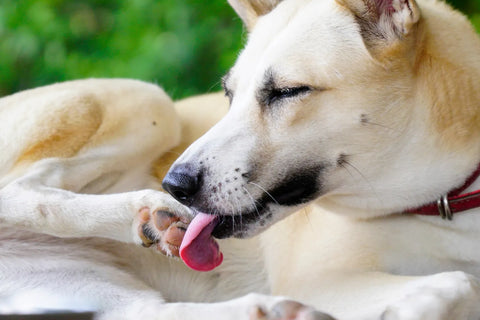
Why Do Dogs Lick Their Paws?

Why Do Dogs Whimper & Make Noises in Their Sleep?
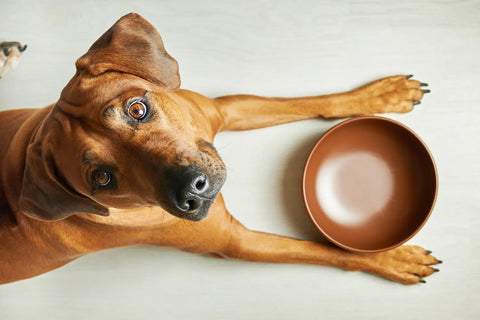
Healthy Vet-Approved Homemade Dog Food Recipes
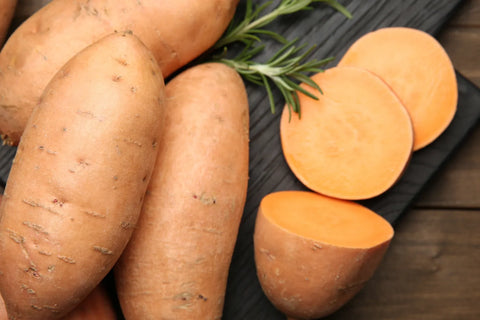
How To Cook Sweet Potatoes for Dogs
